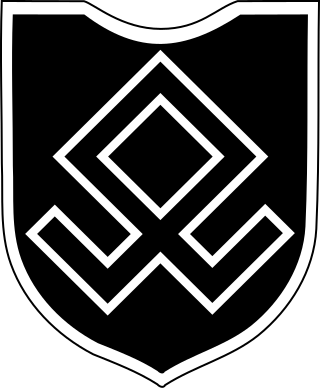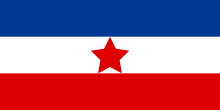
The 21st Waffen Mountain Division of the SS Skanderbeg was a German mountain infantry division of the Waffen-SS, the armed wing of the German Nazi Party that served alongside, but was never formally part of, the Wehrmacht during World War II. At the post-war Nuremberg trials, the Waffen-SS was declared to be a criminal organisation due to its major involvement in war crimes and crimes against humanity.

The 13th Waffen Mountain Division of the SS Handschar was a mountain infantry division of the Waffen-SS, an armed branch of the German Nazi Party that served alongside but was never formally part of the Wehrmacht during World War II. At the post-war Nuremberg trials, the Waffen-SS was declared to be a criminal organisation due to its major involvement in war crimes and crimes against humanity. From March to December 1944, the division fought a counter-insurgency campaign against communist-led Yugoslav Partisan resistance forces in the Independent State of Croatia, a fascist puppet state of Germany that encompassed almost all of modern-day Croatia, all of modern-day Bosnia and Herzegovina and parts of Serbia.
The IX Waffen Mountain Corps of the SS (Croatian) (German: IX. Waffen-Gebirgskorps der SS (Kroatisches)), later simply IX SS Mountain Corps, was a Waffen-SS corps during World War II. Originally set up to control Croatian and Albanian SS divisions, it also commanded a variety of other German and Hungarian units of the Waffen-SS. It saw action on the Eastern Front between July 1944 and January 1945 when it was virtually destroyed during the Siege of Budapest.

The 7th SS Volunteer Mountain Division "Prinz Eugen", initially named the SS-Volunteer Division Prinz Eugen, was a mountain infantry division of the Waffen-SS, an armed branch of the German Nazi Party that served alongside but was never formally part of the Wehrmacht during World War II. At the post-war Nuremberg trials, the Waffen-SS was declared to be a criminal organisation due to its major involvement in war crimes and crimes against humanity. From 1942 to 1945, the division fought a counter-insurgency campaign against communist-led Yugoslav Partisan resistance forces in occupied Yugoslavia. It was formed in 1941 from both Reich Germans and Volksdeutsche – ethnic German volunteers and conscripts from the Banat, Independent State of Croatia, Hungary and Romania. The division surrendered on 11 May 1945 to Yugoslav Partisan forces.

The Black Legion, officially the 1st Standing Active Brigade, was an Ustaše Militia infantry unit active during World War II in Independent State of Croatia. The legion was formed in September 1941 as the 1st Ustaša Regiment. It consisted largely of Bosnian Muslim and Croat refugees from eastern Bosnia, where large massacres were carried out by Chetniks and to a small degree by the Yugoslav Partisans. It became known for its fierce fighting against the Chetniks and the Partisans and massacres against Serb civilians. The legion's commanders were Colonel Jure Francetić and Major Rafael Boban. It consisted of between 1,000 and 1,500 trained mechanized infantrymen.

After the Kingdom of Yugoslavia was invaded by the Axis powers during World War II, all of Bosnia was ceded to the newly created Independent State of Croatia. Axis rule in Bosnia led to widespread persecution and mass-killings of native undesirables and anti-fascists. Many Serbs themselves took up arms and joined the Chetniks, a Serb nationalist and royalist resistance movement that conducted ineffective guerrilla warfare against the occupying Nazi forces. On 12 October 1941 a group of 108 notable Muslim citizens of Sarajevo signed the Resolution of Sarajevo Muslims by which they condemned the persecution of Serbs organized by Ustaše, made distinction between Muslims who participated in such persecutions and whole Muslim population, presented information about the persecutions of Muslims by Serbs and requested security for all citizens of the country, regardless of their identity.

The 23rd Waffen Mountain Division of the SS Kama was a German mountain infantry division of the Waffen-SS, the armed wing of the German Nazi Party that served alongside but was never formally part of the Wehrmacht during World War II. At the post-war Nuremberg trials, the Waffen-SS was declared to be a criminal organisation due to its major involvement in war crimes and crimes against humanity. The division was composed of German officers and Bosnian Muslim soldiers. Named Kama after a small dagger used by Balkan shepherds, it was one of the thirty-eight divisions fielded by the Waffen-SS during World War II. Formed on 19 June 1944, it was built around a cadre from the 13th Waffen Mountain Division of the SS Handschar but did not reach its full strength and never saw action as a formation.

Karl-Gustav Sauberzweig was a German Army Oberst (Colonel) who transferred to the Waffen-SS during World War II and commanded the 13th Waffen Mountain Division of the SS Handschar in 1943–1944, and the IX Waffen Mountain Corps of the SS (Croatian) in 1944–1945, reaching the rank of Gruppenführer and Generalleutnant of the Waffen SS. He returned to the Wehrmacht in January 1945 and was appointed as a Generalleutnant to command a corps within Army Group H in northern Germany. Faced with the prospect of being extradited to Yugoslavia to stand trial for war crimes, Sauberzweig committed suicide in Allied captivity in 1946.

Karl von Krempler, later only Karl Krempler was a German SS-Standartenführer and SS and Police Leader during the Nazi era. In World War II, he was responsible for recruiting Bosniaks from Bosnia and the Sandžak region of Serbia/Montenegro into the Waffen-SS.

Muhamed Hadžiefendić was a Bosnian Muslim officer in the Home Guard of the Independent State of Croatia during World War II, commanding the Hadžiefendić Legion.
The Hadžiefendić Legion or Muslim Legion was a Bosniak self-defence militia and Croatian Home Guard unit based in the predominantly Muslim Tuzla region of the Independent State of Croatia (NDH) during World War II. The brigade–sized force was formally a "Volunteer Home Guard Regiment", and was raised in late December 1941 under the command of the former Royal Yugoslav Army reservist Major Muhamed Hadžiefendić, who had been commissioned into the Croatian Home Guard. By the end of the year, the Legion had commenced forming battalions in six towns in northeastern Bosnia.

The 16th Vojvodina Division was a Yugoslav Partisan division that fought against the Germans, Independent State of Croatia (NDH) and Chetniks in occupied Democratic Federal Yugoslavia during World War II.

The 36th Vojvodina Division was a Yugoslav Partisan division that fought against the Germans, Independent State of Croatia (NDH) and Chetniks in occupied Democratic Federal Yugoslavia during World War II.

The 3rd Corps was a Yugoslav Partisan corps that fought against the Germans, Independent State of Croatia (NDH) and Chetniks in occupied Democratic Federal Yugoslavia during World War II. It was created in November 1942 as the 1st Bosnian Corps, and underwent a name change in 1943. It grew in size until 1 January 1945 when it was subordinated to the Partisan 2nd Army. The 3rd Corps spent most of 1944 engaged in hard fighting against the 13th Waffen Mountain Division of the SS Handschar in eastern Bosnia.

The 27th East Bosnia Division was a Yugoslav Partisan division that fought against the Germans, Independent State of Croatia (NDH) and Chetniks in occupied Yugoslavia during World War II.

The 12th Corps was a corps of the Yugoslav Partisans that fought against the Germans, Independent State of Croatia (NDH) and Chetniks in occupied Democratic Federal Yugoslavia during World War II.

The 38th East Bosnia Division was a Yugoslav Partisan division that fought against the Germans, Independent State of Croatia (NDH) and Chetniks in occupied Democratic Federal Yugoslavia during World War II. As part of the Partisan 3rd Corps it spent the latter half of 1944 engaged in hard fighting against the 13th Waffen Mountain Division of the SS Handschar in eastern Bosnia.

The 11th Krajina Division was a Yugoslav Partisan division that fought against the Germans, Independent State of Croatia (NDH) and Chetniks in occupied Democratic Federal Yugoslavia during World War II. The term krajiška in its name refers to Bosanska Krajina.

Helmuth Raithel was a German officer who held the rank of SS-Standartenführer (colonel) in the Waffen-SS during World War II. While still at school, Raithel was swept up in the excitement of the Munich Beer Hall Putsch of 9 November 1923 led by Adolf Hitler, and was subsequently awarded the coveted Blood Order, even though he was not a member of the Nazi Party. He joined the Reichswehr in 1926. After World War II broke out, he fought in the invasion of Greece in summer 1941, then against the Soviet Red Army in northern Finland before transferring to the Waffen-SS in 1943.
Operation Rübezahl was the name of 3 German anti-partisan operations in Yugoslavia during World War II. The first operation announced the beginning of a strategic retreat by Nazi German troops from Serbia after the front change of Romania and Bulgaria.










